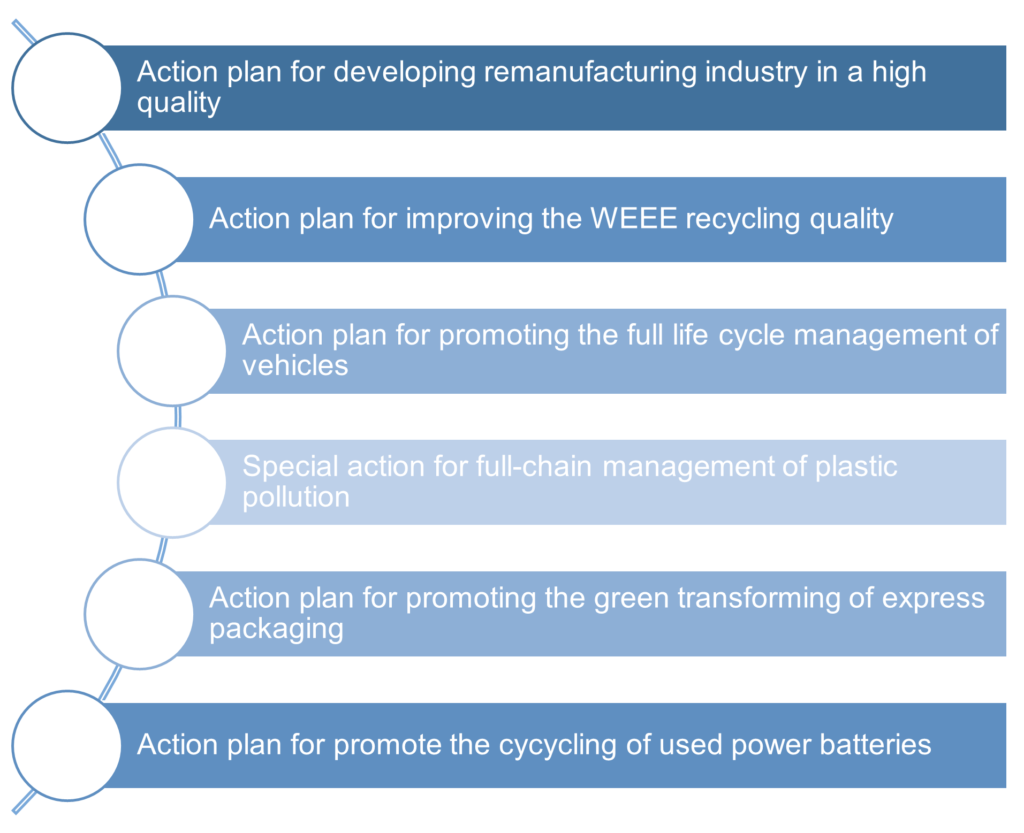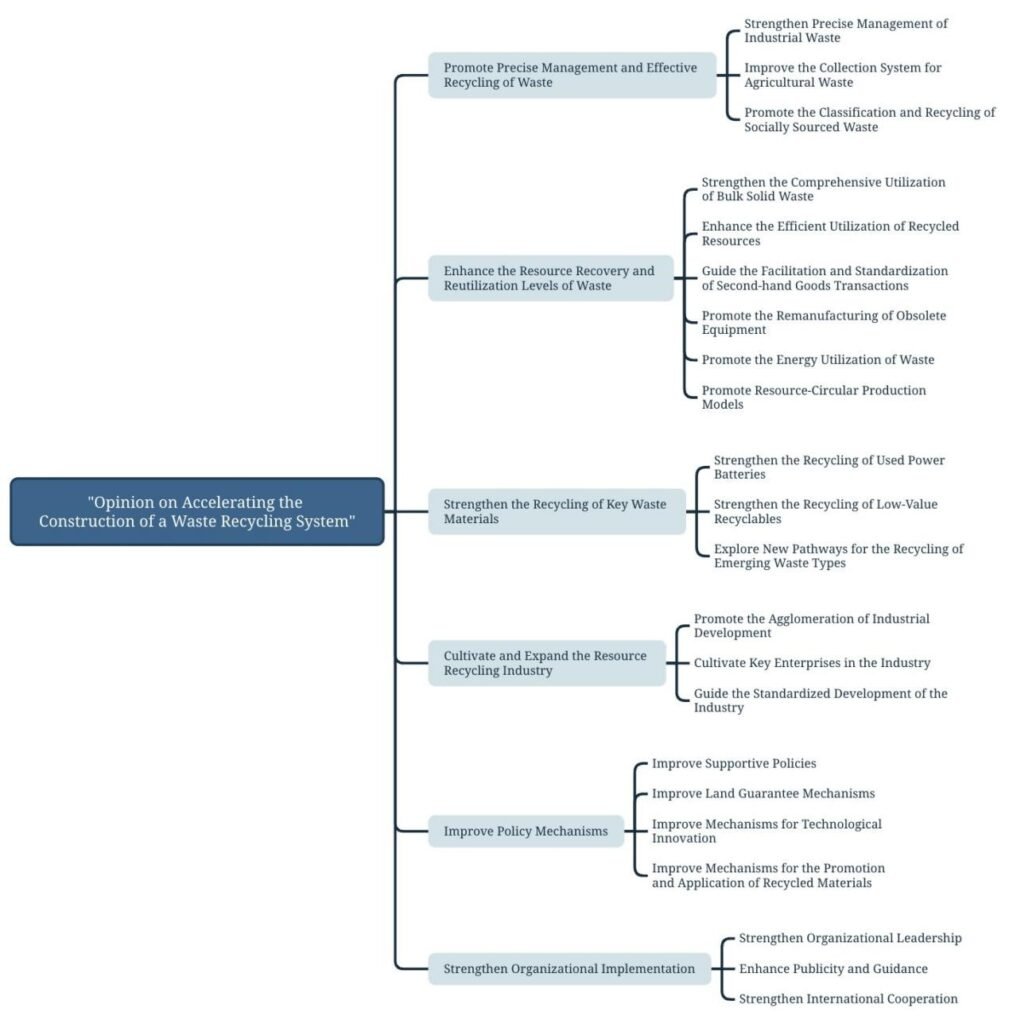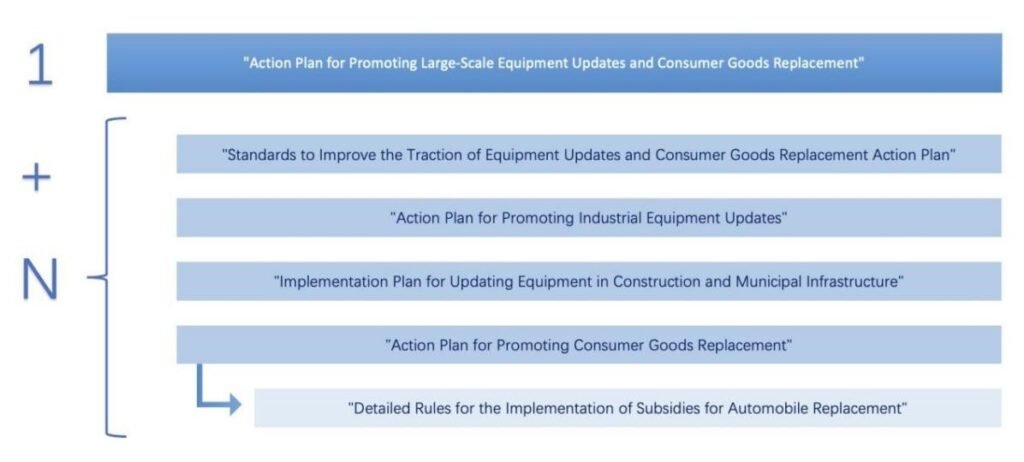Overview
The circular economy focuses on the efficient and cyclical use of resources, guided by the principles of “reduction, reuse, and resource recovery” and characterized by “low consumption, low emissions, and high efficiency.”
In recent years, China has recognized the development of a circular economy as a fundamental pathway to ecological civilization, a necessary requirement for high-quality economic growth, a foundational strategy for addressing resource, environmental, and ecological challenges, and a crucial approach to achieving the goals of “carbon peak and carbon neutrality.” During the “13th Five-Year Plan” period (2016-2020), China effectively improved key indicators of circular economy development, such as the resource output rate, energy consumption per unit of GDP, and the comprehensive utilization rate of crop residues.
For the “14th Five-Year Plan” period (2021-2025), considering global green development trends, climate change mitigation needs, and domestic resource demands and utilization levels, China has continuously introduced various policy standards to vigorously promote the high-quality development of the circular economy.
The “14th Five-Year Plan and the Long-Range Objectives Through the Year 2035” of the People’s Republic of China proposes a comprehensive adoption of the circular economy concept and the establishment of a multi-level, highly efficient resource recycling system. In July 2021, the National Development and Reform Commission issued the “14th Five-Year Plan for the Development of Circular Economy,” further clarifying the goals and paths for China’s circular economy development during the “14th Five-Year” period.
Three key tasks to promote the development of circular economy

Six main actions to promote the development of circular economy

The year 2024 marks a crucial phase in achieving the objectives of the “14th Five-Year Plan.” The Chinese government has introduced multiple policies to accelerate the establishment of waste recycling systems, improve product and equipment recycling systems, and set up national pilot demonstration projects for circular economy standardization.
Major Policies, Regulations, and Standards Related to the Development of China’s Circular Economy Issued in the Past Year
Over the past year, the major policies, regulations, and standards related to the development of China’s circular economy are as follows:
Overview of Major Policies on the Development of China’s Circular Economy in the Past Year
- Improve the construction of waste recycling system
- Opinion of the General Office of the State Council on Accelerating the Construction of Waste Recycling Systems(February 9, 2024)
- Notification by the Standardization Administration and the National Development and Reform Commission on Issuing National Circular Economy Standardization Pilot Demonstration Projects(January 18, 2024)
- Improve the recycling system for key products
- Notification on the Establishment of a Sound Recycling System for Waste Household Appliances and Furniture(January 23, 2024)
- Guideline for Typical Construction Work of a Sound Recycling System for Waste Household Appliances and Furniture(January 24, 2024)
- Notification on the Establishment of a Sound Recycling System for Waste Household Appliances and Furniture(January 23, 2024)
- Promote the recycling of vehicles and power batteries
- Detailed Rules for the Implementation of Subsidies for Automobile Replacement(April 24, 2024)
- Management Measures for the Comprehensive Utilization of New Energy Vehicle Power Batteries (Draft for Comments) (December 18, 2023)
- Promote the green transforming of express packaging
- Notification on the Issuance of the Action Plan for Deepening the Green Transformation of Express Packaging(November 23, 2023)
- Promote the equipment updates and consumer goods replacement
- Guiding Opinions on Coordinating Energy Conservation, Carbon Reduction, and Recycling, and Accelerating the Update and Transformation of Key Area Products and Equipment(February 20, 2023)
- Guiding Opinions of the National Development and Reform Commission and Other Departments on Promoting the Recycling of Retired Wind and Photovoltaic Equipment(July 21, 2023)
- Notification by the State Council on the Issuance of the Action Plan for Promoting Large-Scale Equipment Updates and Consumer Goods Replacement(March 13, 2024)
- Standards to Improve the Traction of Equipment Updates and Consumer Goods Replacement Action Plan(March 27, 2024)
- Action Plan for Promoting Industrial Equipment Updates(March 27, 2024)
- Action Plan for Promoting Consumer Goods Replacement(March 27, 2024)
- Promote the development of remanufacturing industry
- Announcement on Reverse Invoicing Related Matters for Resource Recycling Enterprises to Natural Person Scrap Product Sellers(April 24, 2024
Top-Level Design and Overall Deployment of China’s Waste Recycling System
Opinion of the General Office of the State Council on Accelerating the Construction of a Waste Recycling System
In February 2024, the General Office of the State Council issued the “Opinion on Accelerating the Construction of a Waste Recycling System,” aimed at rapidly establishing a comprehensive, efficient, and well-regulated waste recycling system to promote a comprehensive green transformation of development methods.
The “Opinion” incorporates existing regulations, policies, and practices related to waste materials, garbage, bulk solid waste, recyclable resources, and second-hand goods within the scope of waste. It covers various resource recovery and reuse approaches, including comprehensive utilization, recycling, second-hand trading, remanufacturing, and energy utilization, implementing targeted strategies with precision.
The “Opinion” also sets forth that by 2025, a preliminary waste recycling system covering all fields and stages should be established, achieving significant progress in the recycling of major wastes. The annual utilization of major bulk solid wastes, such as tailings, fly ash, coal gangue, smelting slag, industrial by-product gypsum, construction waste, and straw, is expected to reach 4 billion tons, with the comprehensive utilization rate of newly added bulk solid wastes reaching 60%. The annual utilization of major recyclable resources such as scrap steel, copper, aluminum, lead, zinc, paper, plastic, rubber, and glass is expected to reach 450 million tons. The annual output value of the resource recycling industry is projected to reach 5 trillion yuan.
By 2030, a comprehensive, efficient, and well-regulated waste recycling system is expected to be established, fully exploiting the value of all types of waste resources. The proportion of recycled materials in raw material supply should increase significantly, and the scale and quality of the resource recycling industry should improve markedly, with the overall level of waste recycling being among the world’s leading.
The “Opinion” is problem-oriented, clarifying key tasks such as advancing the detailed management and effective recovery of industrial, agricultural, and societal waste at the front end, improving the utilization level of bulk solid waste, recyclable resources, second-hand goods, and obsolete equipment resources at the back end, and promoting waste recycling pathways and circular production models from the source. Additionally, the “Opinion” pays special attention to emerging key wastes, such as used power batteries, low-value recyclables, and new types of waste, accompanying technological development. Furthermore, the “Opinion” proposes directions for the perfection of corresponding policy mechanisms and organizational support requirements.

Figure 1: Key Task Diagram of the ‘Opinion on Accelerating the Construction of a Waste Recycling System
Focusing on Obsolete Products and Equipment, Promoting Intensive Utilization of Various Resources
Leading through Key Points, Improving the Recycling System in Key Areas
In February 2023, the Development and Reform Commission, Ministry of Industry and Information Technology, Ministry of Finance, and other nine departments jointly issued the “Guiding Opinions on Coordinating Energy Conservation, Carbon Reduction, and Recycling to Accelerate the Update and Transformation of Key Products and Equipment”. These guidelines aim to facilitate the recycling and disposal of old products and equipment, promote high-level recycling of renewable resources, and standardize the remanufacturing of old products and equipment to improve the recycling system. The initial focus of the guidelines includes boilers, motors, electrical transformers, refrigeration, lighting, and household appliances, and an implementation guide for updating and recycling (2023 edition) was also issued to further refine tasks and measures.
In July 2023, the National Development and Reform Commission, National Energy Administration, Ministry of Industry and Information Technology, and other six departments issued the “Guiding Opinions on Promoting the Recycling of Retired Wind and Photovoltaic Equipment”. These guidelines emphasize advancing green design, establishing a robust system for handling retired equipment, enhancing the recycling system, strengthening the capacity for resource regeneration, cautiously advancing equipment remanufacturing, and standardizing the harmless disposal of solid waste, thus building a recycling system for wind and photovoltaic equipment that covers green design, standard recycling, high-value utilization, and harmless disposal. In December of the same year, the Ministry of Industry and Information Technology issued the “Management Measures for the Comprehensive Utilization of New Energy Vehicle Power Batteries (Draft for Comments)”, which set forth regulations for the comprehensive utilization of waste power batteries generated from various stages such as research and development, design, production, installation, use, maintenance, replacement, scrapping, recycling, processing, storage, and transportation. In January of the following year, the Ministry of Commerce, National Development and Reform Commission, Ministry of Industry and Information Technology, and other nine departments jointly issued the “Notification on the Establishment of a Sound Recycling System for Waste Household Appliances and Furniture” and the “Guideline for Typical Construction Work of a Sound Recycling System for Waste Household Appliances and Furniture”. The notification outlines tasks focusing on improving the recycling network, nurturing recycling entities, innovating recycling models, and standardizing recycling activities, including rational planning of the recycling network, leveraging the channels of household appliance manufacturing, distribution, and recycling enterprises, developing “Internet + recycling”, supporting the standardized “car-for-warehouse” recycling, and promoting standardized processing and second-hand goods circulation.
From Line to Scale, Promoting Large-Scale Equipment Updates and Replacement of Consumer Goods
In March 2024, the State Council issued the “Action Plan for Promoting Large-Scale Equipment Updates and Replacement of Consumer Goods”, subsequently deploying a “1+N” policy system. Here, “1” represents the “Action Plan”, and “N” includes several supporting policies such as the “Standards to Improve the Traction of Equipment Updates and Consumer Goods Replacement Action Plan” jointly developed by the State Administration for Market Regulation, National Development and Reform Commission, Ministry of Industry and Information Technology, and other seven departments; the “Action Plan for Promoting Industrial Equipment Updates” issued by the Ministry of Industry and Information Technology, National Development and Reform Commission, Ministry of Finance, and other seven departments; the “Implementation Plan for Updating Equipment in Construction and Municipal Infrastructure” published by the Ministry of Housing and Urban-Rural Development; and the “Action Plan for Promoting Consumer Goods Replacement” jointly issued by the Ministry of Commerce, National Development and Reform Commission, Ministry of Industry and Information Technology, and other fourteen departments.
The “Action Plan” specifically proposes implementing recycling and reuse actions, clearly advocating for the acceleration of the “new replacement + recycling” logistics system and new model development, supporting production and sales enterprises to build a reverse logistics system or cooperate with professional recycling enterprises to improve the old product and equipment recycling network; optimizing second-hand transaction registration management, information sharing, and transaction processes to support the circulation and trading of second-hand goods; promoting traditional equipment remanufacturing, exploring high-end equipment remanufacturing in emerging fields to orderly promote remanufacturing and tiered utilization of old production equipment that meet conditions; and by constructing industrial clusters, enhancing technological levels, and refining policy standards to promote high-level resource regeneration and reuse.

Figure 2: “1+N” Policy System of the ‘Action Plan for Promoting Large-Scale Equipment Updates and Consumer Goods Replacement’
Summarizing Experience, Leveraging the Radiating Effects of Pilot Demonstration Projects
In January 2024, the Standardization Administration and the National Development and Reform Commission issued the “Notification on Issuing National Circular Economy Standardization Pilot Demonstration Projects.” This notification includes 62 national circular economy standardization pilot projects such as “Resource Utilization of Construction Waste” and 6 national circular economy standardization demonstration projects like “Circular Utilization in the Production Process of Biodiesel.”
Table 2: National Circular Economy Standardization Demonstration Projects
| No. | Province | Demonstration Name | Demonstration Owner | Field | Type |
|---|---|---|---|---|---|
| 1 | Hebei | Circular Utilization in the Production Process of Biodiesel National Circular Economy Standardization Demonstration | Tangshan Jinlihai Biodiesel Co., Ltd. | Resource Recycling | Enterprise |
| 2 | Heilongjiang | Coal Chemical Industry National Circular Economy Standardization Demonstration | Baotailong New Materials Co., Ltd. | Comprehensive Utilization of Bulk Solid Waste | Enterprise |
| 3 | Zhejiang | Recycling and Processing of Waste Lead-acid Batteries National Circular Economy Standardization Demonstration | Zhejiang Tianneng Power Material Co., Ltd. | Resource Recycling | Enterprise |
| 4 | Guangdong | Automotive Parts Remanufacturing National Circular Economy Standardization Demonstration | Guangzhou Huadu Global Automatic Transmission Co., Ltd. | Resource Recycling | Enterprise |
| 5 | Guangdong | Waste Battery Recycling and Utilization National Circular Economy Standardization Demonstration | Guangdong Bangpu Recycling Technology Co., Ltd. | Resource Recycling | Enterprise |
| 6 | Gansu | Recycled Resources Recovery and Utilization National Circular Economy Standardization Demonstration | Lanzhou Recycled Resources Recovery Company | Resource Recycling | Enterprise |
Future Development
In summary, the future development of China’s circular economy will continue to focus on building a multi-level, highly efficient resource recycling system, addressing bottlenecks throughout the entire chain from production, consumption, circulation, trade, recycling, to processing and utilization.
In accordance with the circular economy development directions proposed in the “14th Five-Year Plan” outline, China has issued several key documents since 2021. These include the “Notification on Matters Related to the Circular Transformation of Industrial Parks During the 14th Five-Year Plan”, the “Guiding Opinions on the Comprehensive Utilization of Bulk Solid Waste During the 14th Five-Year Plan”, and the “Notification on the Pilot Work of Green Circular Agriculture”. The following year, the “Guiding Opinions on Accelerating the Construction of a Recycling System for Waste Materials” was issued. Additionally, China has successively issued the “Notification on Accelerating the Green Transformation of Express Packaging” and the “Action Plan for Deepening the Green Transformation of Express Packaging” to promote the reduction, standardization, and circularization of express packaging.
The “Opinion on Accelerating the Construction of a Waste Recycling System” issued by the General Office of the State Council addresses overlapping or policy gaps in existing policies targeting different sectors and types of waste disposal. It systematically organizes these issues and specifically addresses the requirements for precise management, effective recycling, and efficient utilization of various categories of waste across all sectors and stages of waste recycling.
To support specific key tasks, China will continue to refine policy mechanisms in areas such as value-added tax and corporate income tax incentives for comprehensive resource utilization, environmental tax policies for solid waste, land guarantee mechanisms for resource recycling projects, a catalog of advanced and applicable technologies and equipment for national industrial resource utilization, and a standards system for recycled materials. For example, in April 2024, the State Taxation Administration issued an “Announcement on ‘Reverse Invoicing’ Related Matters for Resource Recycling Enterprises to Natural Person Scrap Product Sellers” to reduce business costs and solve the problem of VAT deductions for downstream manufacturers caused by the inability of recycling enterprises to provide valid invoices in traditional transactions, thereby encouraging more enterprises to join the resource recycling chain.
 2024 Trends of Circular Economy Policy in China
2024 Trends of Circular Economy Policy in China
























